Mexico, 1982: Paving the Way with Exceptions
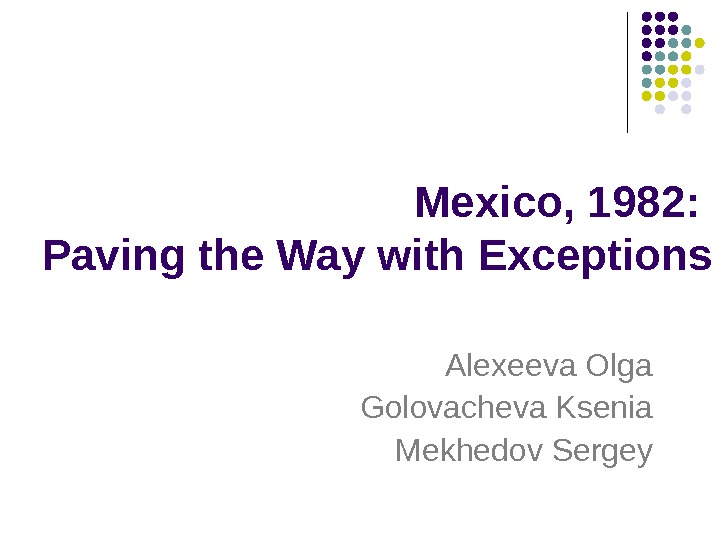
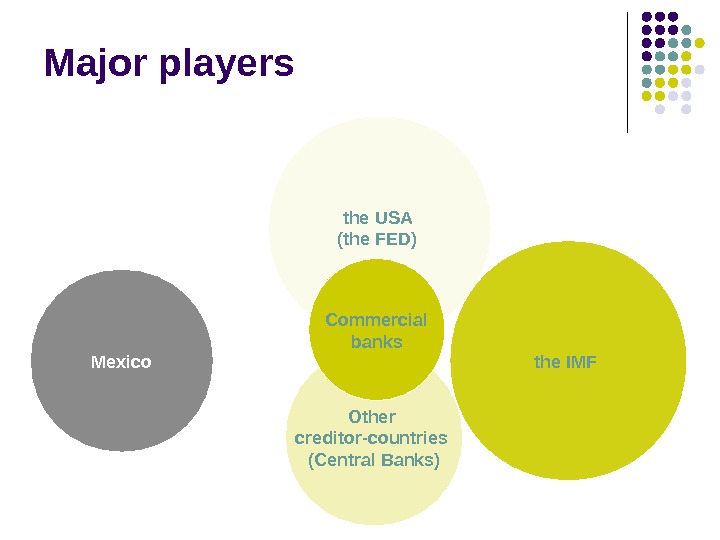
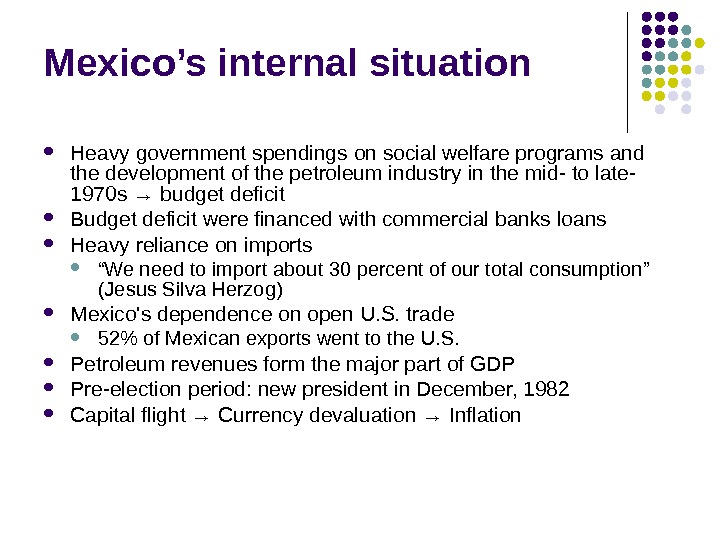
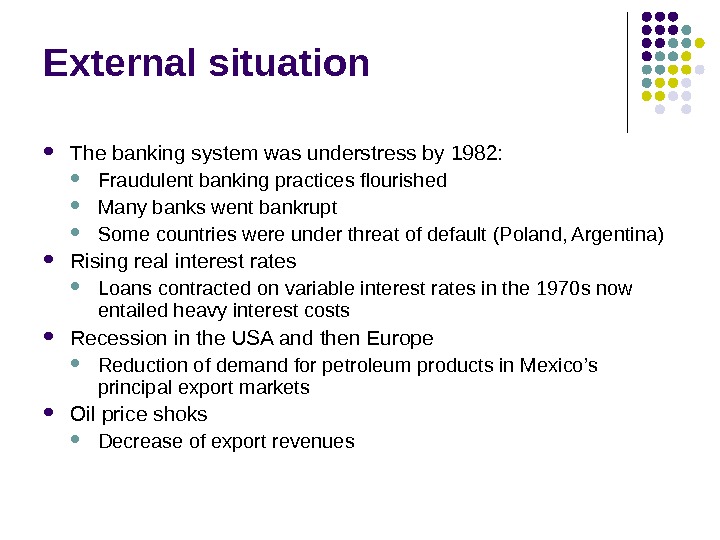


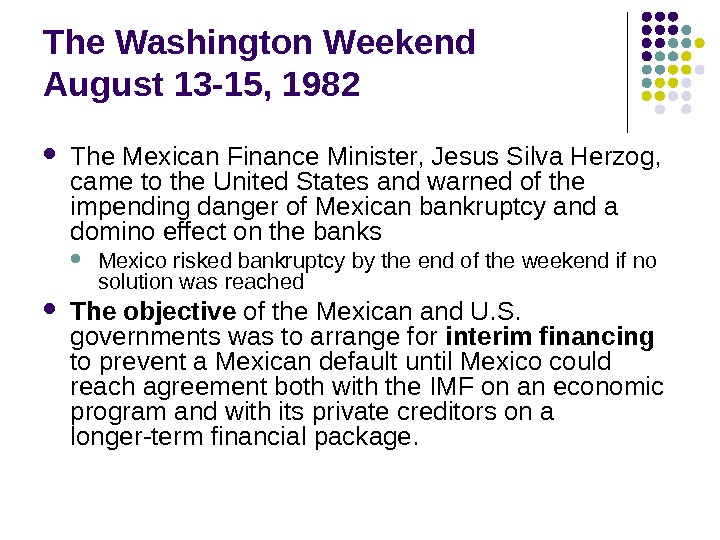
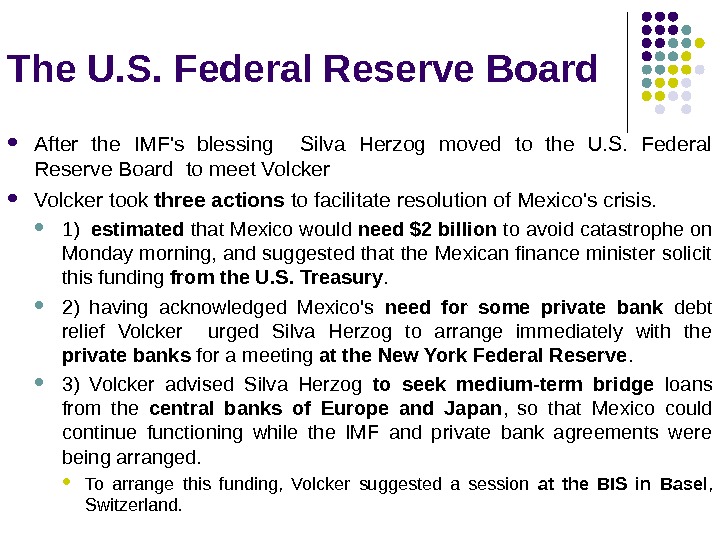
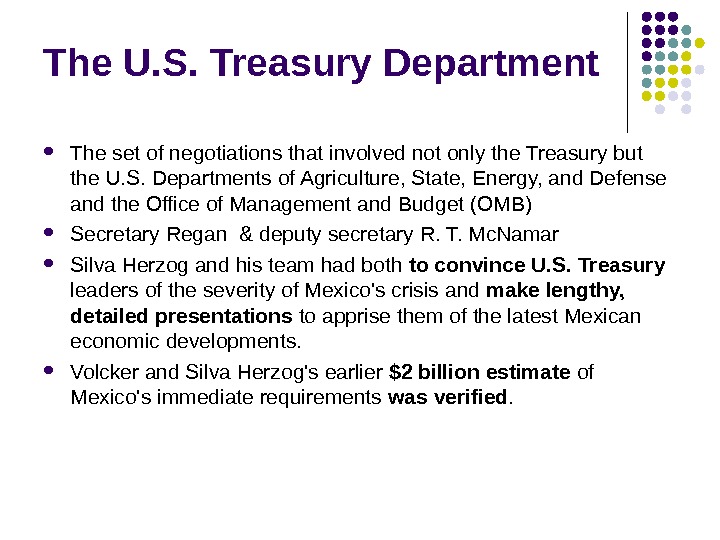
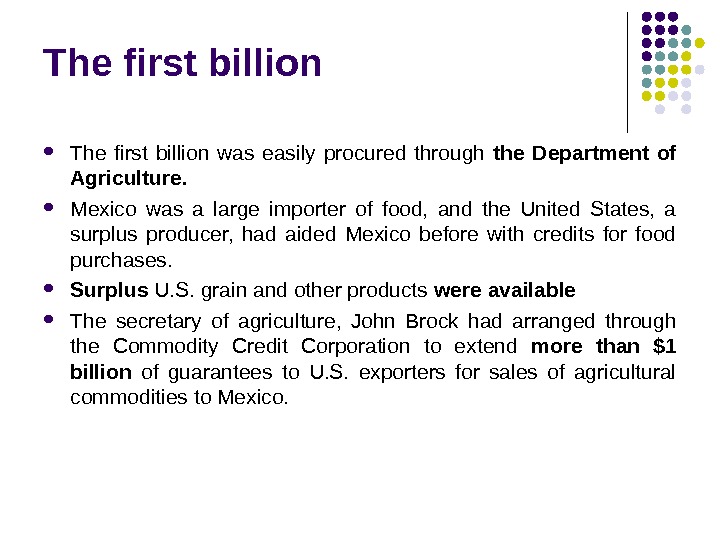
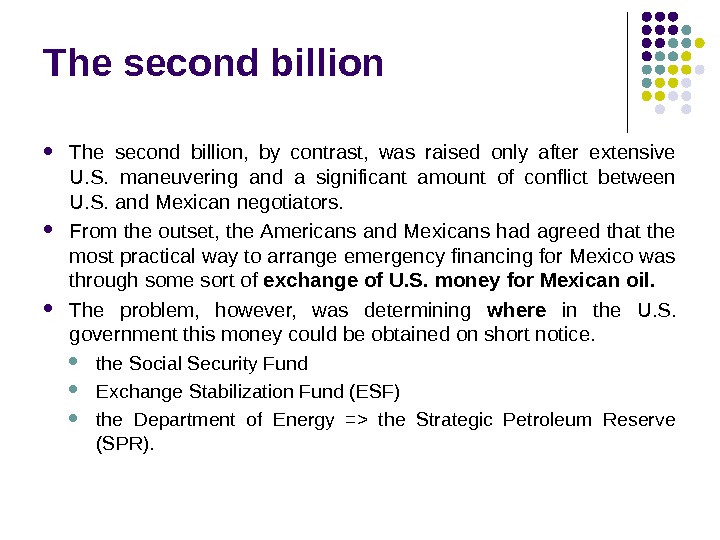
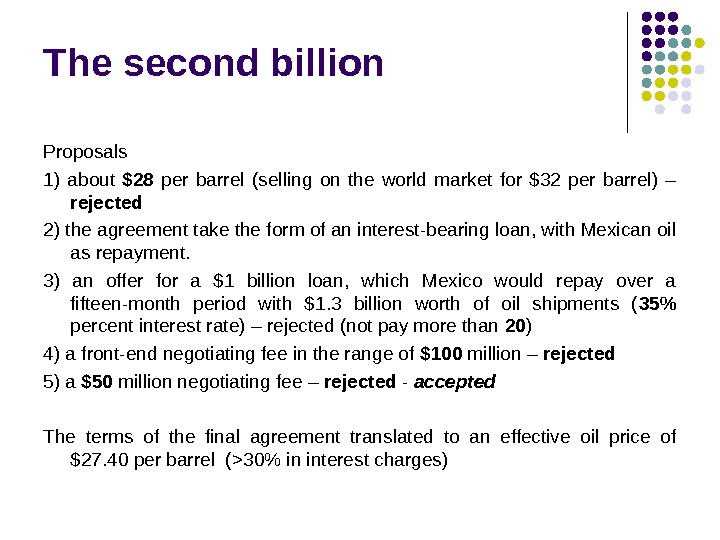

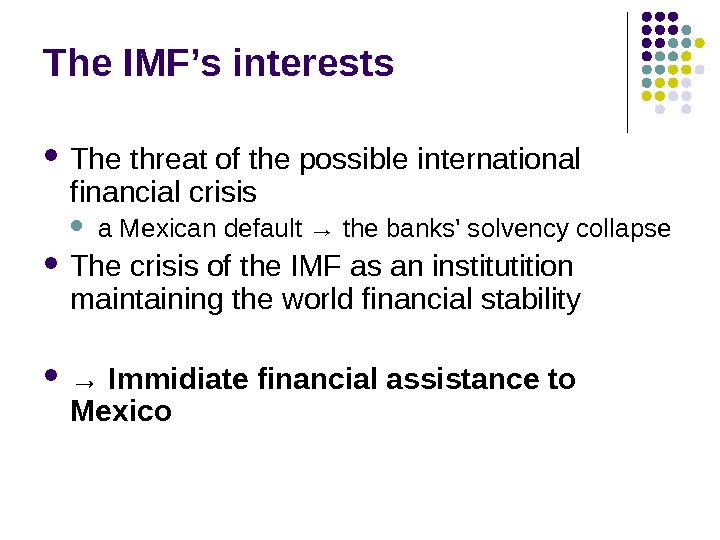
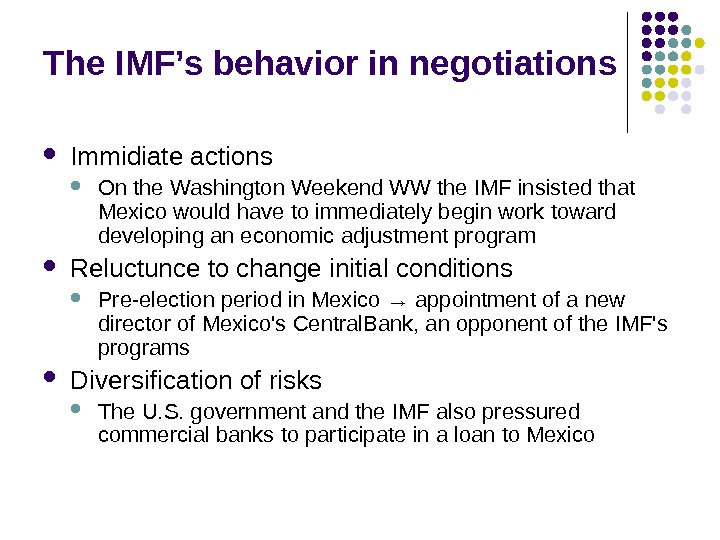
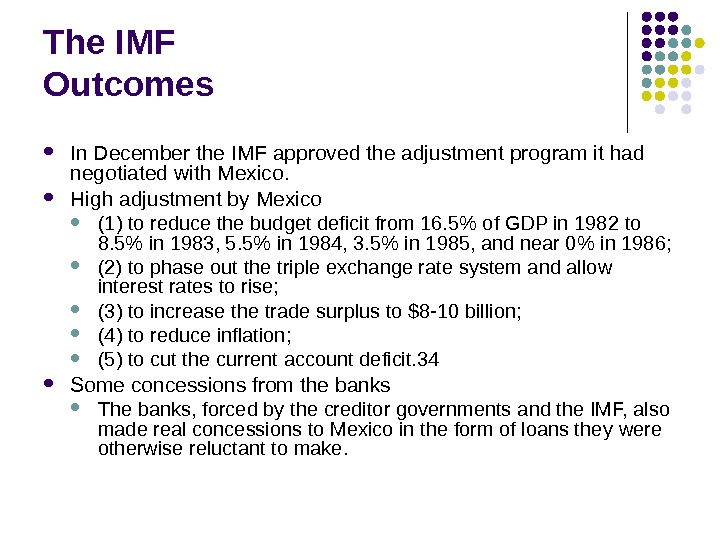
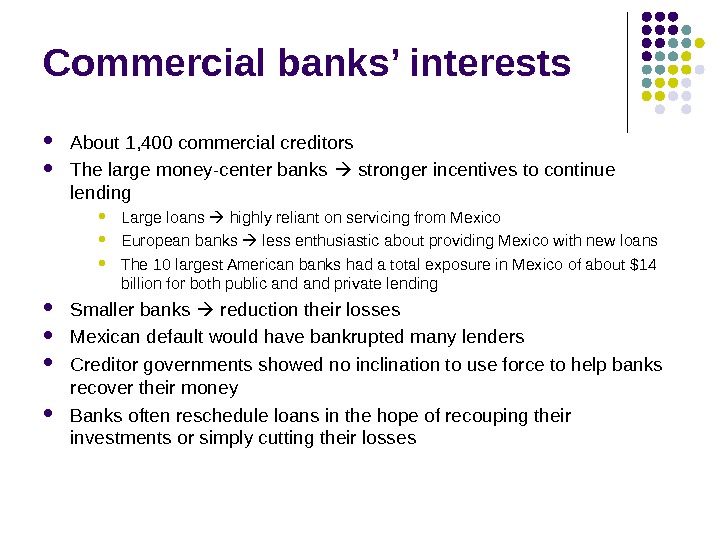
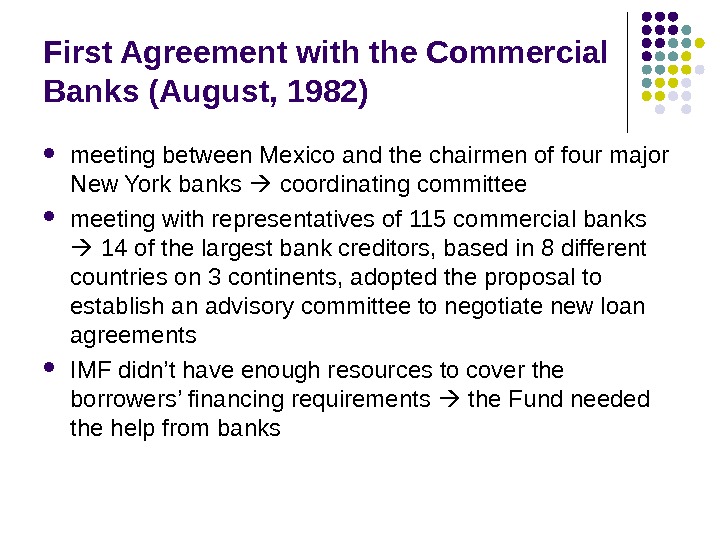
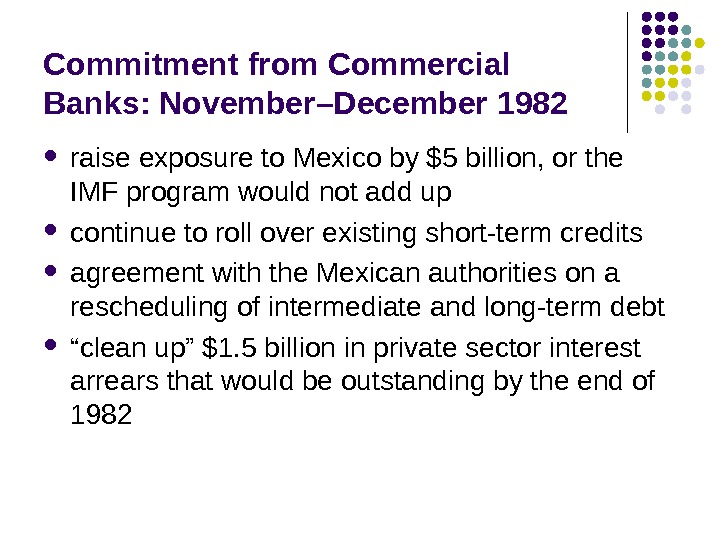

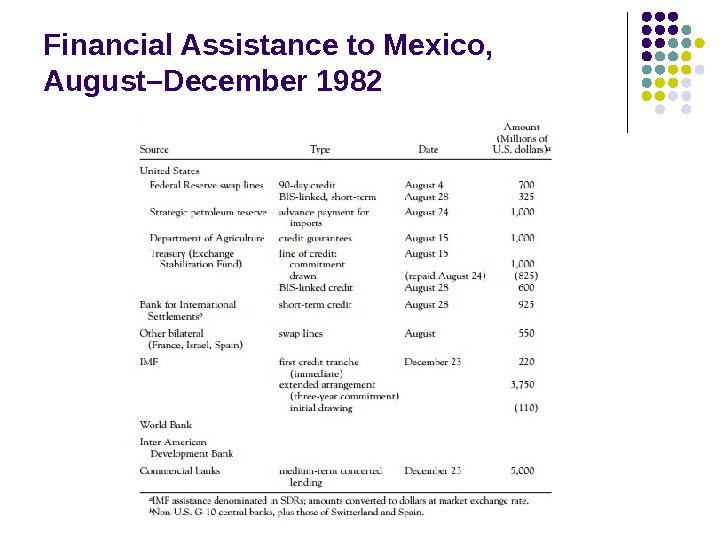


- Размер: 642.5 Кб
- Количество слайдов: 23
Описание презентации Mexico, 1982: Paving the Way with Exceptions по слайдам
 Mexico, 1982: Paving the Way with Exceptions Alexeeva Olga Golovacheva Ksenia Mekhedov Sergey
Mexico, 1982: Paving the Way with Exceptions Alexeeva Olga Golovacheva Ksenia Mekhedov Sergey
 Major players Other creditor-countries (Central Banks) the USA (the FED) the IMF Commercial banks Mexico
Major players Other creditor-countries (Central Banks) the USA (the FED) the IMF Commercial banks Mexico
 Mexico’s internal situation Heavy government spendings on social welfare programs and the development of the petroleum industry in the mid- to late- 1970 s → budget deficit Budget deficit were financed with commercial banks loans H eavy reliance on imports “ We need to import about 30 percent of our total consumption ” ( Jesus Silva Herzog ) Mexico’s dependence on open U. S. t rade 52% of Mexican exports went to the U. S. Petroleum revenues form the major part of GDP Pre-election period: new president in December, 1982 Capital flight → Currency devaluation → Inflation
Mexico’s internal situation Heavy government spendings on social welfare programs and the development of the petroleum industry in the mid- to late- 1970 s → budget deficit Budget deficit were financed with commercial banks loans H eavy reliance on imports “ We need to import about 30 percent of our total consumption ” ( Jesus Silva Herzog ) Mexico’s dependence on open U. S. t rade 52% of Mexican exports went to the U. S. Petroleum revenues form the major part of GDP Pre-election period: new president in December, 1982 Capital flight → Currency devaluation → Inflation
 External situation The banking system was understress by 1982: Fraudulent banking practices flourished Many banks went bankrupt Some countries were under threat of default (Poland, Argentina) Rising real interest rates Loans contracted on variable interest rates in the 1970 s now entailed heavy interest costs Recession in the USA and then Europe Reduction of demand for petroleum products in Mexico’s principal export markets Oil price shoks Decrease of export revenues
External situation The banking system was understress by 1982: Fraudulent banking practices flourished Many banks went bankrupt Some countries were under threat of default (Poland, Argentina) Rising real interest rates Loans contracted on variable interest rates in the 1970 s now entailed heavy interest costs Recession in the USA and then Europe Reduction of demand for petroleum products in Mexico’s principal export markets Oil price shoks Decrease of export revenues
 Mexico: Fiscal Deficit and External Debt, 1971–
Mexico: Fiscal Deficit and External Debt, 1971–
 The USA-Mexico Interconnection Mexican difficulties of any type are of great concern to the USA 1, 760 -mile border ( > 2 832 km) In 1982 -Mexico was the third largest trading partner of the USA sold more oil to the United States than Saudi Arabia purchased U. S. grain in quantities second only to Japan. The United States provided two-thirds of Mexico’s imports. 1981 -1982 the U. S. trade balance with Mexico => from a $4 billion surplus to a $4 billion deficit. US transactions with Mexico in the financial sector were substantial U. S. commercial banks held an estimated 30% of Mexico’s external debt the debt was equivalent to 46% of the capital of the seventeen largest U. S. banks. swap line with the U. S. Federal Reserve system—a testimony to the exceptional importance of Mexico to the U. S. economy. the outflow of Mexican capital to the United States was significant. In 1982, it was estimated that Mexicans had deposits in U. S. banks worth $14 billion, and that they owned an additional $30 billion of U. S. real estate.
The USA-Mexico Interconnection Mexican difficulties of any type are of great concern to the USA 1, 760 -mile border ( > 2 832 km) In 1982 -Mexico was the third largest trading partner of the USA sold more oil to the United States than Saudi Arabia purchased U. S. grain in quantities second only to Japan. The United States provided two-thirds of Mexico’s imports. 1981 -1982 the U. S. trade balance with Mexico => from a $4 billion surplus to a $4 billion deficit. US transactions with Mexico in the financial sector were substantial U. S. commercial banks held an estimated 30% of Mexico’s external debt the debt was equivalent to 46% of the capital of the seventeen largest U. S. banks. swap line with the U. S. Federal Reserve system—a testimony to the exceptional importance of Mexico to the U. S. economy. the outflow of Mexican capital to the United States was significant. In 1982, it was estimated that Mexicans had deposits in U. S. banks worth $14 billion, and that they owned an additional $30 billion of U. S. real estate.
 The Washington Weekend August 13 -15, 1982 T he Mexican Finance Minister, Jesus Silva Herzog, came to the United States and warned of the impending danger of Mexican bankruptcy and a domino effect on the banks Mexico risked bankruptcy by the end of the weekend if no solution was reached The objective of the Mexican and U. S. governments was to arrange for interim financing to prevent a Mexican default until Mexico could reach agreement both with the IMF on an economic program and with its private creditors on a longer-term financial package.
The Washington Weekend August 13 -15, 1982 T he Mexican Finance Minister, Jesus Silva Herzog, came to the United States and warned of the impending danger of Mexican bankruptcy and a domino effect on the banks Mexico risked bankruptcy by the end of the weekend if no solution was reached The objective of the Mexican and U. S. governments was to arrange for interim financing to prevent a Mexican default until Mexico could reach agreement both with the IMF on an economic program and with its private creditors on a longer-term financial package.
 The U. S. Federal Reserve Board After the IMF’s blessing Silva Herzog moved to the U. S. Federal Reserve Board to meet Volcker took three actions to facilitate resolution of Mexico’s crisis. 1) estimated that Mexico would need $2 billion to avoid catastrophe on Monday morning, and suggested that the Mexican finance minister solicit this funding from the U. S. Treasury. 2) having acknowledged Mexico’s need for some private bank debt relief Volcker urged Silva Herzog to arrange immediately with the private banks for a meeting at the New York Federal Reserve. 3) Volcker advised Silva Herzog to seek medium-term bridge loans from the central banks of Europe and Japan , so that Mexico could continue functioning while the IMF and private bank agreements were being arranged. To arrange this funding, Volcker suggested a session at the BIS in Basel , Switzerland.
The U. S. Federal Reserve Board After the IMF’s blessing Silva Herzog moved to the U. S. Federal Reserve Board to meet Volcker took three actions to facilitate resolution of Mexico’s crisis. 1) estimated that Mexico would need $2 billion to avoid catastrophe on Monday morning, and suggested that the Mexican finance minister solicit this funding from the U. S. Treasury. 2) having acknowledged Mexico’s need for some private bank debt relief Volcker urged Silva Herzog to arrange immediately with the private banks for a meeting at the New York Federal Reserve. 3) Volcker advised Silva Herzog to seek medium-term bridge loans from the central banks of Europe and Japan , so that Mexico could continue functioning while the IMF and private bank agreements were being arranged. To arrange this funding, Volcker suggested a session at the BIS in Basel , Switzerland.
 The U. S. Treasury Department The set of negotiations that involved not only the Treasury but the U. S. Departments of Agriculture, State, Energy, and Defense and the Office of Management and Budget (OMB) Secretary Regan & deputy secretary R. T. Mc. Namar Silva Herzog and his team had both to convince U. S. Treasury leaders of the severity of Mexico’s crisis and make lengthy, detailed presentations to apprise them of the latest Mexican economic developments. Volcker and Silva Herzog’s earlier $2 billion estimate of Mexico’s immediate requirements was verified.
The U. S. Treasury Department The set of negotiations that involved not only the Treasury but the U. S. Departments of Agriculture, State, Energy, and Defense and the Office of Management and Budget (OMB) Secretary Regan & deputy secretary R. T. Mc. Namar Silva Herzog and his team had both to convince U. S. Treasury leaders of the severity of Mexico’s crisis and make lengthy, detailed presentations to apprise them of the latest Mexican economic developments. Volcker and Silva Herzog’s earlier $2 billion estimate of Mexico’s immediate requirements was verified.
 The first billion was easily procured through the Department of Agriculture. Mexico was a large importer of food, and the United States, a surplus producer, had aided Mexico before with credits for food purchases. Surplus U. S. grain and other products were available The secretary of agriculture, John Brock had arranged through the Commodity Credit Corporation to extend more than $1 billion of guarantees to U. S. exporters for sales of agricultural commodities to Mexico.
The first billion was easily procured through the Department of Agriculture. Mexico was a large importer of food, and the United States, a surplus producer, had aided Mexico before with credits for food purchases. Surplus U. S. grain and other products were available The secretary of agriculture, John Brock had arranged through the Commodity Credit Corporation to extend more than $1 billion of guarantees to U. S. exporters for sales of agricultural commodities to Mexico.
 The second billion, by contrast, was raised only after extensive U. S. maneuvering and a significant amount of conflict between U. S. and Mexican negotiators. From the outset, the Americans and Mexicans had agreed that the most practical way to arrange emergency financing for Mexico was through some sort of exchange of U. S. money for Mexican oil. The problem, however, was determining where in the U. S. government this money could be obtained on short notice. the Social Security Fund Exchange Stabilization Fund (ESF) the Department of Energy => the Strategic Petroleum Reserve (SPR).
The second billion, by contrast, was raised only after extensive U. S. maneuvering and a significant amount of conflict between U. S. and Mexican negotiators. From the outset, the Americans and Mexicans had agreed that the most practical way to arrange emergency financing for Mexico was through some sort of exchange of U. S. money for Mexican oil. The problem, however, was determining where in the U. S. government this money could be obtained on short notice. the Social Security Fund Exchange Stabilization Fund (ESF) the Department of Energy => the Strategic Petroleum Reserve (SPR).
 The second billion Proposals 1) about $28 per barrel (selling on the world market for $32 per barrel) – rejected 2) the agreement take the form of an interest-bearing loan, with Mexican oil as repayment. 3) an offer for a $1 billion loan, which Mexico would repay over a fifteen-month period with $1. 3 billion worth of oil shipments ( 35% percent interest rate) – rejected (not pay more than 20 ) 4) a front-end negotiating fee in the range of $100 million – rejected 5) a $50 million negotiating fee – rejected — accepted The terms of the final agreement translated to an effective oil price of $27. 40 per barrel (>30% in interest charges)
The second billion Proposals 1) about $28 per barrel (selling on the world market for $32 per barrel) – rejected 2) the agreement take the form of an interest-bearing loan, with Mexican oil as repayment. 3) an offer for a $1 billion loan, which Mexico would repay over a fifteen-month period with $1. 3 billion worth of oil shipments ( 35% percent interest rate) – rejected (not pay more than 20 ) 4) a front-end negotiating fee in the range of $100 million – rejected 5) a $50 million negotiating fee – rejected — accepted The terms of the final agreement translated to an effective oil price of $27. 40 per barrel (>30% in interest charges)
 The BIS Loan Representatives from the central banks of Belgium and Germany expressed doubts about Lopez Portillo’s ultimate willingness to accept IMF conditions in exchange for financial assistance. The French representatives were equally reluctant, and the Europeans felt in general that Mexico was essentially an «American problem. » Under pressure from the U. S. Fed and Bank of England representatives, the Europeans agreed to provide 50% of a $1. 5 billion bridge loan to Mexico. The United States would supply the other 50%. At the end of the session, Spain, as a gesture of support for its former colony, volunteered an additional $175 million. The United States matched that amount as well, bringing the total BIS loan to $1. 85 billion.
The BIS Loan Representatives from the central banks of Belgium and Germany expressed doubts about Lopez Portillo’s ultimate willingness to accept IMF conditions in exchange for financial assistance. The French representatives were equally reluctant, and the Europeans felt in general that Mexico was essentially an «American problem. » Under pressure from the U. S. Fed and Bank of England representatives, the Europeans agreed to provide 50% of a $1. 5 billion bridge loan to Mexico. The United States would supply the other 50%. At the end of the session, Spain, as a gesture of support for its former colony, volunteered an additional $175 million. The United States matched that amount as well, bringing the total BIS loan to $1. 85 billion.
 The IMF’s interests The threat of the possible international financial crisis a Mexican default → the banks’ solvency collapse The crisis of the IMF as an institutition maintaining the world financial stability → Immidiate financial assistance to Mexico
The IMF’s interests The threat of the possible international financial crisis a Mexican default → the banks’ solvency collapse The crisis of the IMF as an institutition maintaining the world financial stability → Immidiate financial assistance to Mexico
 The IMF’s behavior in negotiations Immidiate actions On the Washington Weekend WW the IMF insisted that Mexico would have to immediately begin work toward developing an economic adjustment program Reluctunce to change initial conditions Pre-election period in Mexico → appointment of a new director of Mexico’s Central. Bank , an opponent of the IMF’s programs Diversification of risks The U. S. government and the IMF also pressured commercial banks to participate in a loan to Mexico
The IMF’s behavior in negotiations Immidiate actions On the Washington Weekend WW the IMF insisted that Mexico would have to immediately begin work toward developing an economic adjustment program Reluctunce to change initial conditions Pre-election period in Mexico → appointment of a new director of Mexico’s Central. Bank , an opponent of the IMF’s programs Diversification of risks The U. S. government and the IMF also pressured commercial banks to participate in a loan to Mexico
 The IMF Outcomes I n December the IMF approved the adjustment program it had negotiated with Mexico. H igh adjustment by Mexico (1) to reduce the budget deficit from 16. 5% of GDP in 1982 to 8. 5% in 1983, 5. 5% in 1984, 3. 5% in 1985, and near 0% in 1986; (2) to phase out the triple exchange rate system and allow interest rates to rise; (3) to increase the trade surplus to $8 -10 billion; (4) to reduce inflation; (5) to cut the current account deficit. 34 S ome concessions from the banks The banks, forced by the creditor governments and the IMF, also made real concessions to Mexico in the form of loans they were otherwise reluctant to make.
The IMF Outcomes I n December the IMF approved the adjustment program it had negotiated with Mexico. H igh adjustment by Mexico (1) to reduce the budget deficit from 16. 5% of GDP in 1982 to 8. 5% in 1983, 5. 5% in 1984, 3. 5% in 1985, and near 0% in 1986; (2) to phase out the triple exchange rate system and allow interest rates to rise; (3) to increase the trade surplus to $8 -10 billion; (4) to reduce inflation; (5) to cut the current account deficit. 34 S ome concessions from the banks The banks, forced by the creditor governments and the IMF, also made real concessions to Mexico in the form of loans they were otherwise reluctant to make.
 Commercial banks’ interests About 1, 400 commercial creditors The large money-center banks stronger incentives to continue lending Large loans highly reliant on servicing from Mexico European banks less enthusiastic about providing Mexico with new loans The 10 largest American banks had a total exposure in Mexico of about $14 billion for both public and private lending Smaller banks reduction their losses Mexican default would have bankrupted many lenders Creditor governments showed no inclination to use force to help banks recover their money Banks often reschedule loans in the hope of recouping their investments or simply cutting their losses
Commercial banks’ interests About 1, 400 commercial creditors The large money-center banks stronger incentives to continue lending Large loans highly reliant on servicing from Mexico European banks less enthusiastic about providing Mexico with new loans The 10 largest American banks had a total exposure in Mexico of about $14 billion for both public and private lending Smaller banks reduction their losses Mexican default would have bankrupted many lenders Creditor governments showed no inclination to use force to help banks recover their money Banks often reschedule loans in the hope of recouping their investments or simply cutting their losses
 First Agreement with the Commercial Banks (August, 1982) meeting between Mexico and the chairmen of four major New York banks coordinating committee meeting with representatives of 115 commercial banks 14 of the largest bank creditors, based in 8 different countries on 3 continents, adopted the proposal to establish an advisory committee to negotiate new loan agreements IMF didn’t have enough resources to cover the borrowers’ financing requirements the Fund needed the help from banks
First Agreement with the Commercial Banks (August, 1982) meeting between Mexico and the chairmen of four major New York banks coordinating committee meeting with representatives of 115 commercial banks 14 of the largest bank creditors, based in 8 different countries on 3 continents, adopted the proposal to establish an advisory committee to negotiate new loan agreements IMF didn’t have enough resources to cover the borrowers’ financing requirements the Fund needed the help from banks
 Commitment from Commercial Banks: November–December 1982 raise exposure to Mexico by $5 billion, or the IMF program would not add up continue to roll over existing short-term credits agreement with the Mexican authorities on a rescheduling of intermediate and long-term debt “ clean up” $1. 5 billion in private sector interest arrears that would be outstanding by the end of
Commitment from Commercial Banks: November–December 1982 raise exposure to Mexico by $5 billion, or the IMF program would not add up continue to roll over existing short-term credits agreement with the Mexican authorities on a rescheduling of intermediate and long-term debt “ clean up” $1. 5 billion in private sector interest arrears that would be outstanding by the end of
 Commercial banks’ outcomes Agreement between the Advisory Committee of Commercial Banks and IMF on the financing required to support the Fund program Agreement on the financing proposal between the Advisory Committee and the Mexican authorities
Commercial banks’ outcomes Agreement between the Advisory Committee of Commercial Banks and IMF on the financing required to support the Fund program Agreement on the financing proposal between the Advisory Committee and the Mexican authorities
 Financial Assistance to Mexico, August–December
Financial Assistance to Mexico, August–December
 Summary H igh adjustment by Mexico : To IMF → considerable stabilization package To USA → consessions on future relations USA and IMF as a lever of influence on commercial banks Mexico’s bargaining power Influence Size of a country/debt Strong influence on USA and IMF (and commercial banks indirectly) Strategic significance Strong influence on USA Nonconditional resources Medium influence on the USA Internal bargaining space Week influence on the IM
Summary H igh adjustment by Mexico : To IMF → considerable stabilization package To USA → consessions on future relations USA and IMF as a lever of influence on commercial banks Mexico’s bargaining power Influence Size of a country/debt Strong influence on USA and IMF (and commercial banks indirectly) Strategic significance Strong influence on USA Nonconditional resources Medium influence on the USA Internal bargaining space Week influence on the IM
 Thank you!
Thank you!
